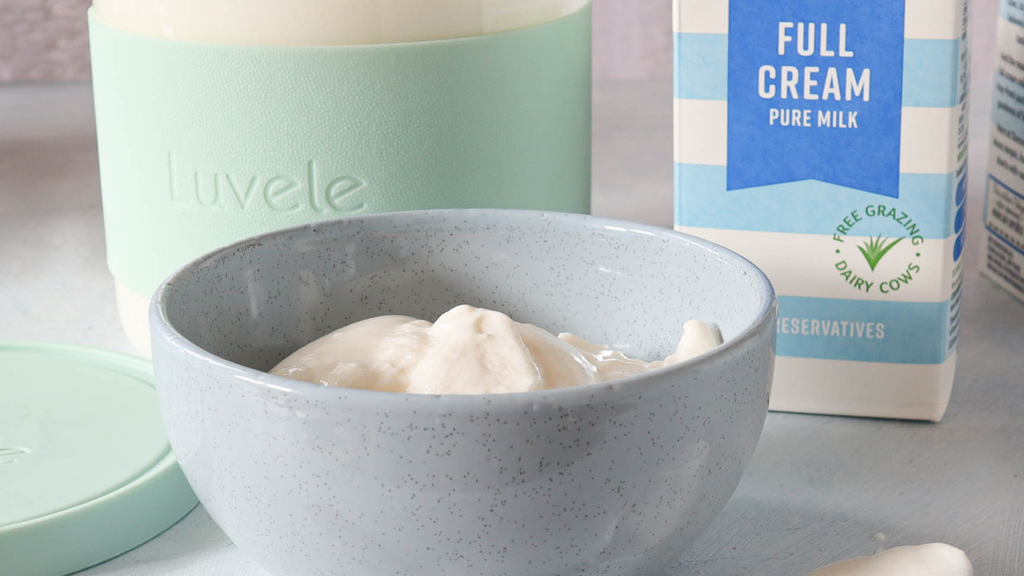Your Cart is Empty
24HR DISPATCH
24HR DISPATCH
24HR DISPATCH

Yogurt made with UHT (long life, shelf stable) whole milk
Barb Hodgens
Barb Hodgens loves to cook with alternative, healthy whole food ingredients, with a focus on gut health. Barb has overcome her own gut health issues through healthy eating. Share your ideas, comments and photos at the end of this post :)

THE EASIEST HOMEMADE YOGURT!
The name ‘shelf stable’ or ‘long-life’ is used to describe milk that has been treated and packaged in a special way to help it last longer without refrigeration. The process is a unique type of pasteurisation called 'ultra-heat-treated' or UHT. UHT milk has a bright white colour and a slightly different taste to regular pasteurised milk and is chemical and preservative free, and can be used to make great homemade yogurt in the Luvele range of yogurt makers.

HOW DOES UHT MILK DIFFER?
The process that leads to this ultra-heat-treated milk is incredibly brief, compared to normal pasteurisation. With regular store-bought milk the pasteurisation process heats milk to 72°C (161.6°F) for at least 15 seconds. The UHT process heats the milk to 135°C (275°F) for only two seconds. The high heat does its work almost instantly. This flash of extreme heat kills all the pathogens in the milk, making it virtually sterile when packaged.
The biggest benefit of UHT milk is that, compared with fresh milk, it has a long shelf life (6 months or more) and can be stored at room temperature. Because no refrigeration is required, UHT milk is vastly cheaper to transport and can be exported to parts of countries that previously had limited dairy. In many parts of the world, long-life milk has become the standard and for many people, it is the only form of milk available.

UHT MILK SIMPLIFIES MAKING YOGURT
We have great news for yogurt lovers. Making yogurt at home with UHT milk is simple and fast. Because this milk is highly sterile, it can be used straight from the carton without heat first.
EXTRA THICK UHT MILK YOGURT
With the combination of a good yogurt starter culture and a 12 to 24-hour fermentation time, UHT milk produces a lovely, bright white, tub set yogurt. If you would like to improve the consistency, you can try one the following additional steps.
1. Adding milk powder increases the volume of milk solid proteins and results in thicker yogurt composition. As a guide add 1/3 cup of dry milk powder to every litre of UHT milk.
2. Strain the yogurt through a muslin cloth after it has chilled. Straining the yogurt removes some of the water content (whey), leaving the fats and proteins behind. The process produces homemade Greek style yogurt.



Yogurt made with UHT (long life, shelf stable) whole milk
Luvele
Rated 3.9 stars by 26 users
The name ‘shelf stable’ or ‘long-life’ is used to describe milk that has been treated and packaged in a special way to help it last longer without refrigeration. The process is a unique type of pasteurisation called 'ultra-heat-treated' or UHT. UHT milk has a bright white colour and a slightly different taste to regular pasteurised milk and is chemical and preservative free, and can be used to make great homemade yogurt in the Luvele range of yogurt makers.
Ingredients
-
2 Litres of UHT whole milk
-
2/3 cup of dry milk powder (optional)
Directions
Pour the UHT milk into the glass yogurt making jar.
OPTIONAL STEP: Add dry milk powder whisk it in. Don’t worry too much if the milk powder does not completely dissolve.
Add the yogurt starter culture and whisk it in.
Secure the lid on, then place the yogurt jar into your yogurt maker.
- Pour water slowly into the base. The water must not be filled over the ‘tall line’ indicated on the inside wall of the maker.
Place the cover lid on top. The UHT milk is now ready to begin fermentation.
Use the digital control panel to set the temperature to 38° C (100° F), the time to between 12 & 24-hours and then press ‘confirm’ to begin incubation.
The alarm will indicate when the fermentation is complete. Condensation will have collected under the cover lid. Please take care removing it and allow the water to drip into the water bath, instead of your bench!
Switch the yogurt maker off and remove the yogurt jar. Straight from the maker the yogurt will be runny and warm. Be gentle with the warm yogurt and don’t stir it or else it won’t set in a perfect white mass.
Place the jar in the fridge for at least 6 hours to chill and set.
Recipe Video

PIN THIS RECIPE


Yogurt made with UHT (long life, shelf stable) whole milk

THE EASIEST HOMEMADE YOGURT!
The name ‘shelf stable’ or ‘long-life’ is used to describe milk that has been treated and packaged in a special way to help it last longer without refrigeration. The process is a unique type of pasteurisation called 'ultra-heat-treated' or UHT. UHT milk has a bright white colour and a slightly different taste to regular pasteurised milk and is chemical and preservative free, and can be used to make great homemade yogurt in the Luvele range of yogurt makers.

HOW DOES UHT MILK DIFFER?
The process that leads to this ultra-heat-treated milk is incredibly brief, compared to normal pasteurisation. With regular store-bought milk the pasteurisation process heats milk to 72°C (161.6°F) for at least 15 seconds. The UHT process heats the milk to 135°C (275°F) for only two seconds. The high heat does its work almost instantly. This flash of extreme heat kills all the pathogens in the milk, making it virtually sterile when packaged.
The biggest benefit of UHT milk is that, compared with fresh milk, it has a long shelf life (6 months or more) and can be stored at room temperature. Because no refrigeration is required, UHT milk is vastly cheaper to transport and can be exported to parts of countries that previously had limited dairy. In many parts of the world, long-life milk has become the standard and for many people, it is the only form of milk available.

UHT MILK SIMPLIFIES MAKING YOGURT
We have great news for yogurt lovers. Making yogurt at home with UHT milk is simple and fast. Because this milk is highly sterile, it can be used straight from the carton without heat first.
EXTRA THICK UHT MILK YOGURT
With the combination of a good yogurt starter culture and a 12 to 24-hour fermentation time, UHT milk produces a lovely, bright white, tub set yogurt. If you would like to improve the consistency, you can try one the following additional steps.
1. Adding milk powder increases the volume of milk solid proteins and results in thicker yogurt composition. As a guide add 1/3 cup of dry milk powder to every litre of UHT milk.
2. Strain the yogurt through a muslin cloth after it has chilled. Straining the yogurt removes some of the water content (whey), leaving the fats and proteins behind. The process produces homemade Greek style yogurt.


:recipekit:

PIN THIS RECIPE


Subscribe
Sign up to get the latest on sales, new releases and more …
